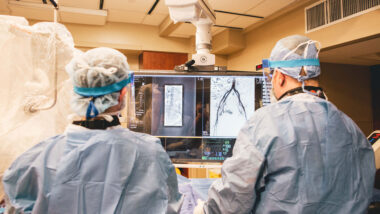Peripheral artery disease (PAD) is a cardiovascular condition where blood flow is reduced due to narrowed arteries, the blood vessels that carry blood from the heart to the rest of the body. Noticeable symptoms of PAD typically happen in the feet and legs. One common symptom is leg cramping pain during activity that improves after rest. Decreased circulation also affects other aspects of your health, including sleep. As PAD worsens, it may cause rest pain, which is typically a constant dull aching or burning pain, that can worsen when lying flat. Knowing the best sleeping position for peripheral artery disease can help relieve the symptoms of PAD. Still, if you’re experiencing night-time leg pain, it’s also time to see a vascular specialist for an evaluation.
Understanding PAD
The most common cause of PAD is atherosclerosis, which is plaque build-up in the arteries. PAD may not have any symptoms in the early stages. As the condition progresses, it often leads to:
- Aches, cramping, heaviness or pain in the legs while walking, also known as claudication
- Blue, discolored or pale coloring in the foot or leg
- Feet or legs that are cool to the touch
- Rest pain, a burning-like pain in the feet often made worse by lying on your back
- Sores or wounds on the feet or lower legs that are slow to heal
The Connection Between Sleep, Pain and PAD
The amount and quality of sleep you get is directly connected to your heart health. Adults who consistently get less than seven hours of sleep each night, have insomnia or have irregular sleep patterns have a higher risk of developing cardiovascular conditions, including PAD. Too little sleep is also associated with high blood pressure, obesity and Type 2 diabetes.
Sleep conditions, such as obstructive sleep apnea and restless leg syndrome, are more common in people with PAD, further interfering with sleep. Rest pain can also interfere with a good night’s sleep. This symptom happens in the later stages of PAD and may be a sign of limb-threatening disease. However, you don’t need to live with the pain. Treatment can help.
When to Seek Professional Care
The interventional radiology experts at Vascular & Interventional Specialists at Charlotte Radiology offer several minimally invasive procedures to treat PAD, which are usually used in conjunction:
- Atherectomy — a device is used to remove plaque build-up in the arteries.
- Balloon angioplasty — a balloon is used to stretch open a narrowed or blocked artery.
- Stent placement — a metal tube is placed to stretch open a narrowed or blocked, typically used if the vessel does not stay open after balloon angioplasty.
If you’re experiencing rest pain or other possible symptoms of PAD, it’s time to seek care. Early treatment can decrease symptoms, improve circulation, and prevent PAD progression.
Tips for Improved Sleep
Getting adequate sleep and paying attention to your sleep position can help manage symptoms while seeking treatment for PAD. Practicing good sleep habits and selecting the right mattress and pillow for your needs can also improve your sleep quality.
To set yourself up for success:
- Avoid caffeine in the afternoon and evening
- Exercise throughout the day
- Have a consistent bedtime and wake time
- Keep your bedroom cool, dark and quiet
- Turn off all electronics at least a half hour before bedtime
Choosing the Best Sleeping Position for PAD
While the sleep position you choose matters, there isn’t a one-size-fits-all solution. If you have peripheral artery disease, the best sleeping position depends on several factors, including whether you have other health conditions.
Sleeping on your back puts less stress on the spine and offers good weight distribution. Small pillows under the lower back or knees further decrease pressure and increase comfort. However, this position may interfere with breathing if you have sleep apnea. It can also increase rest pain.
Similarly, sleeping on your side has pros and cons. In people with PAD and sleep apnea, side sleeping can help keep airways open but may interfere with alignment. Placing a pillow between your knees can help keep your spine straight. Sleeping on the right or left side may also make a difference. When lying on your left, gravity causes your heart to move slightly toward the side, affecting heart activity. In contrast, the lungs and chest muscles help stabilize the heart when lying on the right.
If you experience rest pain with PAD, elevating the head of your bed a few inches to keep your legs lower than your heart can improve blood flow to the feet and may also decrease discomfort. Still, even with improved sleep, treatment to prevent PAD from worsening is essential.



